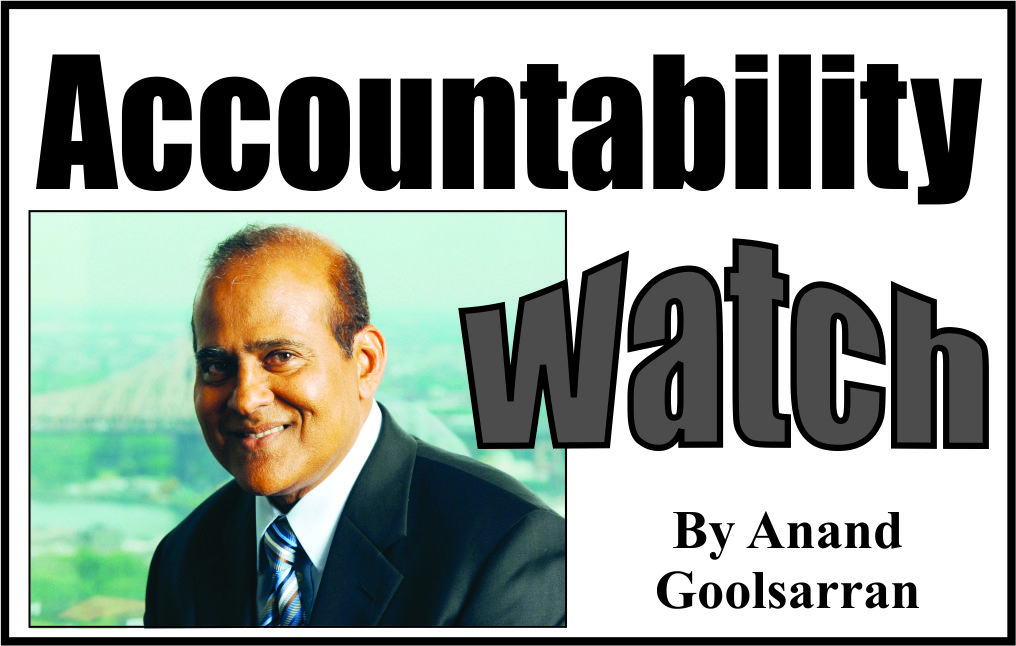In last week’s article, we began a discussion of the important topic of public financial management (PFM), drawing in part on the contents of the recently released Inter-American Development Bank (IDB) report entitled “Economic Institutions for a Resilient Caribbean” as well as our own experience of the subject. In this article, we continue from where we left off.
Assessment of the soundness of PFM
According to the Public Expenditure and Financial Accountability (PEFA) Secretariat, an open and orderly PFM system is one that enables:
(a) Effective controls of the budget totals and management of fiscal risks thereby contributing to maintaining aggregate fiscal discipline;
(b) Strategic allocation of resources involving planning and executing the budget in line with government priorities aimed at achieving policy objectives; and
(c) The use of budgeted revenues to achieve the best levels of public services within available resources.
The PEFA Performance Measurement Framework referred to last week identifies the following seven broad areas, known as pillars:
(a) Budget reliability: The government budget must be realistic and implemented as intended. This is achieved by comparing actual revenues and expenditures with the original approved budget;
(b) Transparency of public finances: Information on PFM must be comprehensive, consistent, and accessible to users. This is achieved through comprehensive budget classification, transparency of all government revenue and expenditure including intergovernmental transfers, published information on service delivery performance and ready access to fiscal and budget documentation;
(c) Management of assets and liabilities: Effective management of assets and liabilities is necessary to ensure that public investments provide value for money, assets are recorded and managed, fiscal risks are identified, and debts and guarantees are prudently planned, approved, and monitored;
(d) Policy-based fiscal strategy and budgeting: The fiscal strategy and the budget must be prepared with due regard to government fiscal policies, strategic plans, and adequate macroeconomic and fiscal projections;
(e) Predictability and control in budget execution: The budget should be implemented within a system of effective standards, processes, and internal controls, thereby ensuring that resources are obtained and used as intended;
(f) Accounting and reporting: Accurate and reliable records must be maintained, and information produced and disseminated at appropriate times to meet decision-making, management, and reporting needs; and
(g) External audit and scrutiny: Public finances should be independently reviewed and there is follow-up on the implementation of recommendations for improvement by the Executive.
Within each pillar, there are 31 performance indicators which are further disaggregated into 94 dimensions. For example, Pillar VII (External Audit and Scrutiny) has two performance indicators, namely external audit; and legislative scrutiny of audit reports. These are further broken down into eight dimensions: audit coverage and standards; submission of audit reports to the Legislature; external audit follow-up; external auditor’s independence; timing of audit report scrutiny; hearings on audit findings; recommendations on audit by the Legislature; and transparency and scrutiny of audit reports.
The performance of each indicator is measured on a scale from A to D. The highest score, A, is given if the evidence clearly demonstrates that an internationally-recognized level of good performance is achieved. The D score indicates that performance is below the basic level.
Indicators with more than one dimension are scored according to either the lowest score amongst its dimensions or the average of its dimension scores. The results of the individual indicator assessments are used to provide an integrated assessment of the PFM system against the seven pillars. This integrated assessment facilitates an overall assessment of the likely impact of PFM performance on the three desired budgetary outcomes: aggregate fiscal discipline, strategic allocation of resources, and efficient service delivery.
The culmination of a PEFA assessment is a report that provides an overview of the PFM system and evidence-based measurement against 31 performance indicators. It also provides an assessment of the implications for overall system performance and desirable PFM outcomes; and a foundation for reform planning, dialogue on strategy and priorities, and the monitoring of progress.
Guyana has had two PEFA assessments so far (2007 and 2019), the results of which have not been made public. The first assessment remains in draft.
Findings and recommendations on Guyana’s PFM systems
According to the report, Guyana is at critical point, with revenues from oil and gas expected to provide additional fiscal resources over the medium-term, especially as regards social and infrastructure spending. In this regard, the Natural Resource Fund (NRF) Act provides an appropriate framework for such resources as well as savings for future generations. However, the legal and regulatory framework for the oil and gas industry needs to be strengthened. The report, however, did not indicate that three key aspects of the NRF are yet to be operationised. These are:
(a) The establishment of the Investment Commit-tee comprising six members having experience and expertise in financial investments and portfolio management;
(b) Public Oversight and Accountability Commit-tee comprising 22 members drawn from mainly civil society organisations, to monitor compliance with the Act as well as independent assessment of the management of the Fund and the utilization of withdrawals; and
(c) The Macroeconomic Committee to advise the Minister on the Economically Sustainable Amount. This is the maximum amount that can be withdrawn from the NRF in a fiscal year while ensuring the long-term financial sustainability of the Fund, a fair inter-generational distribution of natural resource wealth, and maintaining stability in the annual withdrawals from the Fund.
Also not mentioned is the Petroleum Commission Bill 2017 which was tabled in the National Assembly but remains in draft. The Bill provides for the establishment a Petroleum Commission to oversee and manage the oil and gas industry to ensure, among others, compliance with the policies, laws and agreements relating to petroleum operations, including compliance with health, safety and environmental standards as well as local content and participation requirements. It will also be responsible for researching efficient, safe, effective and environmentally responsible exploration, development and production of petroleum in Guyana, including the optimum methods of exploring and extracting petroleum and petroleum products. The Commission is to act as an advisory body to the Minister, and its board of directors is to comprise experts in various fields as well as representatives of civil society and the parliamentary opposition. It will access the necessary bodies of knowledge about the industry so as to avoid dependence on petroleum operators for information.
The report noted improvements in ICT, especially the implementation of the Integrated Financial Management and Accounting System (IFMAS). However, as we have highlighted as far back as 2014, two important modules were never activated since IFMAS was introduced in 2004. These are the Purchasing Module and Assets & Inventory Module. It is no wonder that Guyana has scored poorly in these two areas based on various assessments carried out.
Despite efforts over the years to strengthen aspects of PFM, such as the passing of the Fiscal Management and Accountability Act 2003 and the Audit Act 2004, significant weaknesses still remain. The PRODEV index scored Guyana at 2.0 which is below the regional average of 2.9. (The PRODEV Evaluation Tool breaks down PFM into three interrelated components, namely: budgeting and financial management; procurement; and internal and external auditing.) The keys weaknesses relate to the following:
(a) Policy-based fiscal strategy and budgeting;
(b) Predictability and control in budget execution, including insufficient legislative scrutiny of external audit reports;
(c) Management of assets and liabilities;
(d) Transparency in intergovernmental fiscal relations, including lack of information on the resources received by delivery units;
(e) Uncompetitive procurement, resulting in substandard provision and low value for money, and procurement inefficiencies, together with a lack of feasibility studies and rigorous project appraisals, which result in lower implementation and investment inefficiency;
(f) Lack of any tender notices on the National Procurement and Tender Administration Board’s (NPTAB) website, which contradicts international practice;
(g) Inefficient and paper-based bureaucratic processes; and
(h) Public investment management, particularly in state-owned enterprises.
In order to address these weaknesses, the report recommended the following:
(a) Strengthen the budget preparation process, macroeconomic and fiscal forecasting, fiscal strategy, and medium-term perspectives in expenditure budgeting;
(b) Simplify the budget classification system, which is rather complex, with many programmes, sub-programmes, and activities as well as economic classification codes;
(c) Enhance public investment management, fiscal risk reporting, and public debt management;
(d) Complete the upgrade of the IFMAS to allow the government to implement a sole PFM platform for all public expenditures, streamline budgetary processes, phase out cheque payments, and further implement the Treasury Single Account;
(e) Improve the accounting, recording, and reporting systems;
(f) Strengthen external scrutiny and audit, including legislative oversight; and
(g) Improve transparency, including through performance information for service delivery, and provide more detailed information in in-year budget reports;
Findings and recommendations on Guyana’s procurement system
Procurement practices continue to receive the lowest scores in successive PEFA assessments due to the following:
(a) Poor competition, value for money, and procurement controls;
(b) Significant gaps, especially in relation to the institutional framework and management capacity, market practices, and transparency of the system, as well as the need ensure fairness, transparency, and best value;
(c) Weak linkages between in-year budget adjustments and procurement plans;
(d) Weak internal controls within personnel and procurement management;
(e) Little progress to measure and publicly report data in critical areas such as competitive tendering; and
(f) Public protests related to corruption in the procurement process and the perception that large swathes of the procurement process are closed to some bidders.
The report has made several recommendations to address the deficiencies identified, including:
(a) Strengthen the NPTAB and the monitoring and oversight role of the Public Procurement Commission;
(b) Include procurement below the threshold stipulated in law in NPTAB reports. (The low rating referred to above reflects the large amount of procurement outside the NPTAB’s remit, such as that conducted by agencies and state-owned enterprises);
(c) Establish an impartial appeals/complaints mechanism, as provided for in the Procurement Act;
(d) Abandon the use of non-competitive procurement methods. (Competitive methods account for 72 percent of purchases of goods, services, and works);
(e) Reinforce monitoring of contract implementation to ensure quality and pricing;
(f) Provide full transparency to the procurement process, for example, by making information available on procurement and contract awards and introducing an interactive procurement portal;
(g) Describe and make public the extent to which the NPTAB assists government agencies in pre-qualifying bidders, and in preparing selection criteria for higher-valued procurement;
(h) Implement the Procurement Act requirement to publish procurement awards within seven days of the award to enhance transparency, and disseminate data about the resolution of procurement complaints;
(i) Update legislation to enable electronic transactions, and implement training and certification as well as an e-tendering system;
(j) Establish internal and external procurement audit capacity; and
(k) Expand the NPTAB to include full private sector participation, and ensure membership rotation to improve its effectiveness.
Public Investment Management
Guyana’s Public Investment Management is 1.5 times less efficient than comparable countries, with an estimated efficiency gap of 41 percent compared to 30 percent in Latin America and the Caribbean countries, and 27 percent in Emerging Market Economies.
Key weaknesses identified relate to planning, budgeting, appraisal, selection, procurement, and implementation of capital projects. In addition, investment planning does not appear to be guided by an explicit fiscal objective and is not constrained by a medium-term fiscal envelope. Further, the Medium-Term Budget Framework lacks solid indicative forward estimates to guide capital spending budgeting. In particular, there are no annual or medium-term ceilings on capital or recurrent spending, and published information on full life-cycle costs of capital projects is not comprehensive.
Concluding remarks
Most of the observations made in the IDB report are not new and have been dealt with, perhaps in a more comprehensive way, in several of our columns. In the final analysis, the success of any PFM reform initiatives and their long-term sustainability will be greatly enhanced when the initiatives, though professional in nature, are backed by strong political will, support and commitment.
It is now left on the Administration to implement the recommendations. The ball is now in the Minister of Finance’s court.









